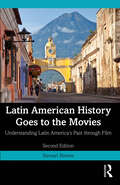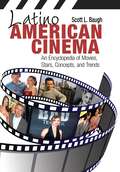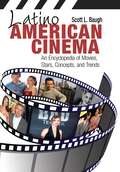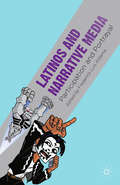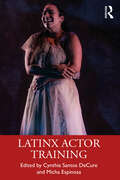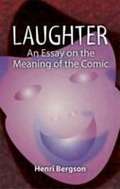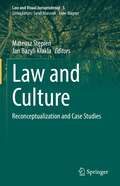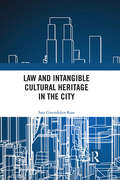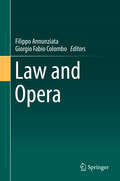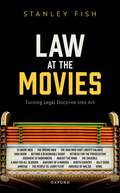- Table View
- List View
Latin American Film Industries (International Screen Industries)
by Tamara L. FalicovFilm production in Latin America is as old as cinema itself, but local film industries have always been in a triangulated relationship with Hollywood and European cinema. This book situates Latin American film industries within the global circulation of film production, exhibition and distribution, charting the changes that the industries have undergone from the sound era to the present day. Focusing in particular on Argentina, Brazil and Mexico, Tamara Falicov examines commonalities among Latin American film industries, such as the challenges of procuring funding, competition from Hollywood, state funding battles, and the fickle nature of audiences, as well as censorship issues, competition from television, and the transnational nature of Latin American film. She addresses production, exhibition, and distribution contexts and financing and co-production with Europe and the United States, as well as the role of film festivals in funding and circulating films both within and outside of Latin America. Newer trends such as the revival of protectionist measures like the screen quota are framed in contrast to the U.S.'s push for trade policy liberalization and issues of universal concern such as film piracy, and new technologies and the role of television in helping and hindering Latin American cinema.
Latin American Film Industries (International Screen Industries)
by Tamara L. FalicovFilm production in Latin America is as old as cinema itself, but local film industries have always been in a triangulated relationship with Hollywood and European cinema. This book situates Latin American film industries within the global circulation of film production, exhibition and distribution, charting the changes that the industries have undergone from the sound era to the present day. Focusing in particular on Argentina, Brazil and Mexico, Tamara Falicov examines commonalities among Latin American film industries, such as the challenges of procuring funding, competition from Hollywood, state funding battles, and the fickle nature of audiences, as well as censorship issues, competition from television, and the transnational nature of Latin American film. She addresses production, exhibition, and distribution contexts and financing and co-production with Europe and the United States, as well as the role of film festivals in funding and circulating films both within and outside of Latin America. Newer trends such as the revival of protectionist measures like the screen quota are framed in contrast to the U.S.'s push for trade policy liberalization and issues of universal concern such as film piracy, and new technologies and the role of television in helping and hindering Latin American cinema.
Latin American History Goes to the Movies: Understanding Latin America's Past through Film
by Stewart BrewerThis new edition of Latin American History Goes to the Movies uses a variety of feature films as a method of studying key historical themes in Latin America, from pre-Columbian cultures to contemporary debates. The book provides historical context as a way of interpreting Latin American filmography, offering multiple classroom viewing options per chapter theme. Each chapter is dedicated to a central concept or issue, such as stereotypes, conquest and colonialism, revolution, religion, gender, and politics. The second edition includes four additional chapters on dictatorships, LGBTQIA+ issues, the environment, and Indigenous peoples. Twenty new films, including La Fiesta del Chivo, Fresa y Chocolate, Embrace of the Serpent, and Roma appear throughout this edition, presenting additional perspectives and updates for today’s readers. The discussions of films and the history behind them offer a flexible and nuanced approach to understanding Latin American cultures, differentiating between stereotypical depictions and the realities of history. Concise and accessible, Latin American History Goes to the Movies is a unique resource for students and instructors in Latin American history and film studies to analyse developments in Latin America throughout previous centuries.
Latin American History Goes to the Movies: Understanding Latin America's Past through Film
by Stewart BrewerThis new edition of Latin American History Goes to the Movies uses a variety of feature films as a method of studying key historical themes in Latin America, from pre-Columbian cultures to contemporary debates. The book provides historical context as a way of interpreting Latin American filmography, offering multiple classroom viewing options per chapter theme. Each chapter is dedicated to a central concept or issue, such as stereotypes, conquest and colonialism, revolution, religion, gender, and politics. The second edition includes four additional chapters on dictatorships, LGBTQIA+ issues, the environment, and Indigenous peoples. Twenty new films, including La Fiesta del Chivo, Fresa y Chocolate, Embrace of the Serpent, and Roma appear throughout this edition, presenting additional perspectives and updates for today’s readers. The discussions of films and the history behind them offer a flexible and nuanced approach to understanding Latin American cultures, differentiating between stereotypical depictions and the realities of history. Concise and accessible, Latin American History Goes to the Movies is a unique resource for students and instructors in Latin American history and film studies to analyse developments in Latin America throughout previous centuries.
The Latin American Road Movie (Global Cinema)
by Verónica Garibotto Jorge PérezThis volume explores the ways films made by Latin American directors and/or co-produced in Latin American countries have employed the road movie genre to address the reconfiguration of the geographical, sociopolitical, economic, and cultural landscape of Latin America.
Latin American Women Filmmakers: Production, Politics, Poetics (World Cinema)
by Deborah Martin Deborah ShawLatin American women filmmakers have achieved unprecedented international prominence in recent years. Notably political in their approach, figures such as Lucrecia Martel, Claudia Llosa and Bertha Navarro have created innovative and often challenging films, enjoying global acclaim from critics and festival audiences alike. They undeniably mark a 'moment' for Latin American cinema.
Latin Dance (The American Dance Floor)
by Elizabeth Drake-BoytThis title in the American Dance Floor series provides an overview of the origins, development, and current status of Latin social dancing in the United States.Latin dance and music have had a widespread influence upon the development of other social dance and music styles in the United States. As a result, Latin dance styles are among the most important dance forms in America.Latin Dance addresses every major style of Latin dance, describing the basic steps that characterize it as well as its rhythmic pace and time signature, and examining its development from European, African, and Amerindian influences. The author explains the range of styles and expression to be found in Latin dances primarily within the context of couples social dancing, the popularity of salsa today, and the broader social meanings and implications of their multicultural origins from the 1600s to the present. The historic connection between exhibition Latin dance and American modern dance through vaudeville is explained as well.
Latinidad and Film: Queer and Feminist Cinema in the Americas
by Rosana Blanco-Cano Dania Abreu-Torres Rita E. Urquijo-RuizThis book provides an analysis of Latinidad in Latin American and U.S. Latinx films by women and/or LGBTQ directors from 1991 to 2016. Challenging traditional notions of gender roles, family, and national identities, it discusses how film directors are broadening the canon and producing provocative work that challenges the boundaries of identity. Utilizing a feminist and queer lens, this book is intended to demonstrate the dynamic interactions between individual agency, choices, and freedom from the communities represented. The book's organization in three parts reflects a common core of the Latin American and U.S. Latinx experiences, unifying all these films in the hope of creating a better understanding of these geographical regions and their people.
Latino American Cinema: An Encyclopedia of Movies, Stars, Concepts, and Trends
by Scott L. BaughLatino American cinema is a provocative, complex, and definitively American topic of study. This book examines key mainstream commercial films while also spotlighting often-underappreciated documentaries, avant-garde and experimental projects, independent productions, features and shorts, and more.Latino American Cinema: An Encyclopedia of Movies, Stars, Concepts, and Trends serves as an essential primary reference for students of the topic as well as an accessible resource for general readers. The alphabetized entries in the volume cover the key topics of this provocative and complex genre—films, filmmakers, star performers, concepts, and historical and burgeoning trends—alongside frequently overlooked and crucially ignored items of interest in Latino cinema. This comprehensive treatment bridges gaps between traditional approaches to U.S.-Latino and Latin American cinemas, placing subjects of Chicana and Chicano, Puerto Rican, Cuban and diasporic Cuban, and Mexican origin in perspective with related Central and South American and Caribbean elements. Many of the entries offer compact definitions, critical discussions, overviews, and analyses of star artists, media productions, and historical moments, while several foundational entries explicate concepts, making this single volume encyclopedia a critical guide as well.
Latino American Cinema: An Encyclopedia of Movies, Stars, Concepts, and Trends
by Scott L. BaughLatino American cinema is a provocative, complex, and definitively American topic of study. This book examines key mainstream commercial films while also spotlighting often-underappreciated documentaries, avant-garde and experimental projects, independent productions, features and shorts, and more.Latino American Cinema: An Encyclopedia of Movies, Stars, Concepts, and Trends serves as an essential primary reference for students of the topic as well as an accessible resource for general readers. The alphabetized entries in the volume cover the key topics of this provocative and complex genre—films, filmmakers, star performers, concepts, and historical and burgeoning trends—alongside frequently overlooked and crucially ignored items of interest in Latino cinema. This comprehensive treatment bridges gaps between traditional approaches to U.S.-Latino and Latin American cinemas, placing subjects of Chicana and Chicano, Puerto Rican, Cuban and diasporic Cuban, and Mexican origin in perspective with related Central and South American and Caribbean elements. Many of the entries offer compact definitions, critical discussions, overviews, and analyses of star artists, media productions, and historical moments, while several foundational entries explicate concepts, making this single volume encyclopedia a critical guide as well.
Latinos and Narrative Media: Participation and Portrayal
by Frederick Luis AldamaThis is the first book to explore the multitude of narrative media forms created by and that feature Latinos in the twenty-first century - a radically different cultural landscape to earlier epochs. The essays present a fresh take informed by the explosion of Latino demographics and its divergent cultural tastes.
Latinx Actor Training
by Cynthia Santos DeCure Micha EspinosaLatinx Actor Training presents essays and pioneering research from leading Latinx practitioners and scholars in the United States to examine the history and future of Latino/a/x/e actor training practices and approaches. Born out of the urgent need to address the inequities in academia and the industry as Latinx representation on stage and screen remains disproportionately low despite population growth; this book seeks to reimagine and restructure the practice of actor training by inviting deep investigation into heritage and identity practices. Latinx Actor Training features contributions covering current and historical acting methodologies, principles, and training, explorations of linguistic identity, casting considerations, and culturally inclusive practices that aim to empower a new generation of Latinx actors and to assist the educators who are entrusted with their training. This book is dedicated to creating career success and championing positive narratives to combat pervasive and damaging stereotypes. Latinx Actor Training offers culturally inclusive pedagogies that will be invaluable for students, practitioners, and scholars interested in the intersections of Latinx herencia (heritage), identity, and actor training.
Latinx Actor Training
by Cynthia Santos DeCure Micha EspinosaLatinx Actor Training presents essays and pioneering research from leading Latinx practitioners and scholars in the United States to examine the history and future of Latino/a/x/e actor training practices and approaches. Born out of the urgent need to address the inequities in academia and the industry as Latinx representation on stage and screen remains disproportionately low despite population growth; this book seeks to reimagine and restructure the practice of actor training by inviting deep investigation into heritage and identity practices. Latinx Actor Training features contributions covering current and historical acting methodologies, principles, and training, explorations of linguistic identity, casting considerations, and culturally inclusive practices that aim to empower a new generation of Latinx actors and to assist the educators who are entrusted with their training. This book is dedicated to creating career success and championing positive narratives to combat pervasive and damaging stereotypes. Latinx Actor Training offers culturally inclusive pedagogies that will be invaluable for students, practitioners, and scholars interested in the intersections of Latinx herencia (heritage), identity, and actor training.
Laughing Fit to Kill: Black Humor in the Fictions of Slavery
by Glenda CarpioReassessing the meanings of "black humor" and "dark satire," Laughing Fit to Kill illustrates how black comedians, writers, and artists have deftly deployed various modes of comedic "conjuring"--the absurd, the grotesque, and the strategic expression of racial stereotypes--to redress not only the past injustices of slavery and racism in America but also their legacy in the present. Focusing on representations of slavery in the post-civil rights era, Carpio explores stereotypes in Richard Pryor's groundbreaking stand-up act and the outrageous comedy of Chappelle's Show to demonstrate how deeply indebted they are to the sly social criticism embedded in the profoundly ironic nineteenth-century fiction of William Wells Brown and Charles W. Chesnutt. Similarly, she reveals how the iconoclastic literary works of Ishmael Reed and Suzan-Lori Parks use satire, hyperbole, and burlesque humor to represent a violent history and to take on issues of racial injustice. With an abundance of illustrations, Carpio also extends her discussion of radical black comedy to the visual arts as she reveals how the use of subversive appropriation by Kara Walker and Robert Colescott cleverly lampoons the iconography of slavery. Ultimately, Laughing Fit to Kill offers a unique look at the bold, complex, and just plain funny ways that African American artists have used laughter to critique slavery's dark legacy.
Laughter: An Essay on the Meaning of the Comic
by Henri BergsonIn this great philosophical essay, Henri Bergson explores why people laugh and what laughter means. Written at the turn of the twentieth century, Laughter explores what it is in language that makes a joke funny and what it is in us that makes us laugh. One of the functions of humor, according to Bergson, is to help us retain our humanity during an age of mechanization. Like other philosophers, novelists, poets, and humorists of his era, Bergson was concerned with the duality of man and machine. His belief in life as a vital impulse, indefinable by reason alone, informs his perception of comedy as the relief we experience upon distancing ourselves from the mechanistic and materialistic. "A situation is always comic," Bergson notes, "if it participates simultaneously in two series of events which are absolutely independent of each other, and if it can be interpreted in two quite different meanings. " The philosopher's thought-provoking insights (e. g. , "It seems that laughter needs an echo. Our laughter is always the laughter of a group. ") keep this work ever-relevant as a thesis on the principles of humor.
Laughter in Occupied Palestine: Comedy and Identity in Art and Film (International Library of Visual Culture)
by Chrisoula LionisAlthough the political situation in Palestine is more serious than ever, contemporary Palestinian art and film are, paradoxically, becoming more humorous in their responses. Laughter in Occupied Palestine looks deeply into this trend, and is the first book to provide an overview of Palestinian art and film, showing the ways in which both art forms have developed in reaction to critical moments in Palestinian history over the last century. Chrisoula Lionis analyzes both the impetus behind this shift toward humour and its consequences, arguing that it has flourished amid political uncertainty and the decline in nationalist hope. Revealing the crucial role of jokes in responding to the failure of the peace process and ongoing occupation, she unearths the potential of laughter to facilitate understanding and empathy in a time of conflict and division.
L'avventura (BFI Film Classics)
by Geoffrey Nowell-SmithThis study provides a detailed account of the 1960s film, 'L'avventura', arguing that in order to appreciate its greatness it is necessary to understand not only that the film is a classic but also that it represents a revolution in cinema.
L'avventura (BFI Film Classics)
by Geoffrey Nowell-SmithThis study provides a detailed account of the 1960s film, 'L'avventura', arguing that in order to appreciate its greatness it is necessary to understand not only that the film is a classic but also that it represents a revolution in cinema.
Law and Culture: Reconceptualization and Case Studies (Law and Visual Jurisprudence #5)
by Mateusz Stępień Jan Bazyli KlaklaDivided into three parts, this book examines the relationship between law and culture from various perspectives, both theoretical and empirical. Part I outlines the framework for further considerations and includes new, innovative conceptualizations of two ideas that are essential to the topic of law and culture: legal culture and customary law. Both of these reappear later in the more empirically oriented chapters of Parts II and III. Part II includes chapters on the relationships between law, customs, and culture, drawing heavily on the tradition and achievements of the anthropology of law and touching on important problems of multiculturalism, legal pluralism, and cultural defense. It focuses on the more intangible meaning of culture, while Part III addresses its more material, tangible aspects and the issue of cultural production, as well as its intersection with law.
Law and Intangible Cultural Heritage in the City
by Sara Gwendolyn RossWith disappearing music venues, and arts and culture communities at constant risk of displacement in our urban centers, the preservation of intangible cultural heritage is of growing concern to global cities. This book addresses the role and protection of intangible cultural heritage in the urban context. Using the methodology of Urban Legal Anthropology, the author provides an ethnographic account of the civic effort of Toronto to become a Music City from 2014-18 in the context of redevelopment and gentrification pressures. Through this, the book elucidates the problems cities like Toronto have in equitably protecting intangible cultural heritage and what can be done to address this. It also evaluates the engagement that Toronto and other cities have had with international legal frameworks intended to protect intangible cultural heritage, as well as potential counterhegemonic uses of hegemonic legal tools. Understanding urban intangible cultural heritage and the communities of people who produce it is of importance to a range of actors, from urban developers looking to formulate livable and sustainable neighbourhoods, to city leaders looking for ways in which their city can flourish, to scholars and individuals concerned with equitability and the right to the city. This book is the beginning of a conservation about what is important for us to protect in the city for future generations beyond built structures, and the role of intangible cultural heritage in the creation of full and happy lives. The book is of interest to legal and sociolegal readers, specifically those who study cities, cultural heritage law, and legal anthropology.
Law and Intangible Cultural Heritage in the City
by Sara Gwendolyn RossWith disappearing music venues, and arts and culture communities at constant risk of displacement in our urban centers, the preservation of intangible cultural heritage is of growing concern to global cities. This book addresses the role and protection of intangible cultural heritage in the urban context. Using the methodology of Urban Legal Anthropology, the author provides an ethnographic account of the civic effort of Toronto to become a Music City from 2014-18 in the context of redevelopment and gentrification pressures. Through this, the book elucidates the problems cities like Toronto have in equitably protecting intangible cultural heritage and what can be done to address this. It also evaluates the engagement that Toronto and other cities have had with international legal frameworks intended to protect intangible cultural heritage, as well as potential counterhegemonic uses of hegemonic legal tools. Understanding urban intangible cultural heritage and the communities of people who produce it is of importance to a range of actors, from urban developers looking to formulate livable and sustainable neighbourhoods, to city leaders looking for ways in which their city can flourish, to scholars and individuals concerned with equitability and the right to the city. This book is the beginning of a conservation about what is important for us to protect in the city for future generations beyond built structures, and the role of intangible cultural heritage in the creation of full and happy lives. The book is of interest to legal and sociolegal readers, specifically those who study cities, cultural heritage law, and legal anthropology.
Law and Opera
by Filippo Annunziata Giorgio Fabio ColomboThis book explores the various connections between Law and Opera, providing a comprehensive, multinational, and multidisciplinary (with approaches from jurists, philosophers, musicologist, historians) resource on the subject. Further, it makes a valuable contribution to studies on law and the humanities. While, for example, the relationship between law and literature has been extensively researched, the relationship between Law and Opera remains largely overlooked. The book approaches the topic from three perspectives in three main sections: Law in Opera, Law on Opera, and Law around Opera.
Law and Order (BFI TV Classics)
by Charlotte BrunsdonL?aw and Order is a police story, a crime series, a courtroom drama and a prison film. Written by G. F. Newman, directed by Les Blair and produced by Tony Garnett, Law and Order challenges the comfortable world of the television police series to reveal the proximity of police and villains in a world of deals, set-ups and mutually advantageous financial arrangements. The 1978 series, shot in a low-key naturalistic style, was so controversial when first broadcast that the BBC could neither repeat nor export it, and BBC news teams were excluded from prisons. Now available on DVD, Law and Order is, Charlotte Brunsdon argues, an 'absent classic' in the history of British television drama.This carefully-researched and elegantly-argued study offers close analysis of the four films, while also showing how Law and Order comments on contemporary criminal justice scandals and exploring the outrage that the broadcasts caused the year before the election of the 1979 Thatcher government. It uses interviews with the makers of the programmes to show how the films were made, and original archive research about the BBC's response to the subsequent protests in a period of political instability. Charlotte Brunsdon argues that now the shocking claims of the series have been accepted as 'true enough', it is time to recognise its aesthetic achievement, and restore Law and Order to its place within the canon of great British television drama. Law and Order offers a much bleaker vision of 1970s policing than Life on Mars and re-runs of The Sweeney, and this study shows how the series draws on the tradition of 'serious television drama' and the popular police series to change ideas about both television serial drama and British criminal justice.
Law at the Movies: Making Change in the Networked Public Sphere (Law and Literature)
by Thomas J BillardTransgender rights have emerged as an important topic of everyday conversation across the country in recent years and become, in many ways, the flashpoint du jour of the American culture wars. During the Trump presidency in particular, transgender people were thrust onto the center stage of US politics. Faced with unrelenting hostility and an increasingly complicated media system, transgender activists crafted new communication strategies to fight for their equality, stall attempts to undermine their rights, and win the support of large swathes of the public. In Voices for Transgender Equality, Thomas J Billard offers an insider's view into transgender activism during the first two years of the Trump administration. Drawing on extensive on-the-ground observation at the National Center for Transgender Equality, Billard shows how these activists developed an unlikely blend of online and offline strategies to saturate a diverse ecology of national news outlets, local and community media outlets across the country, and both public and private conversations across multiple social media platforms with voices in support of their cause. Moreover, these activists navigated the complex flows of information and ideas among these different domains of the communication system as they worked to shape the national conversation on transgender rights. As Billard argues, this movement occurred at a very particular time in the development of the media system, with "new" media shaping the movement in important ways that are both generalizable to other social movements and unique to transgender activism. Including rich storytelling and insightful analysis, Voices for Transgender Equality makes a compelling case of what it takes to make social and political change in a world transformed by digital media. Along the way, Billard provides key insights into the new business-as-usual of mediated politics and valuable lessons for more effective activism.
Law at the Movies: Turning Legal Doctrine into Art (Law and Literature)
by Prof Stanley FishThis book asks "How can legal doctrine be turned into filmic art?" By "legal doctrine" Stanley Fish does not mean the sonorous abstractions that usually accompany the self-presentation of law--Justice, Equity, Equality, Liberty, Autonomy, and the like. Rather he has in mind the specific rules and procedures invoked and analyzed by courts on the way to declaring a decision--lawyer/client confidentiality, the distinction between interdicted violence and the violence performed by the legal system, the interplay of positive law and laws rooted in morality, the difference between civilian law and military law, the death penalty, the admissibility of different forms of evidence. In the movies he discusses, these and other points of doctrine and procedure do not serve as a background, occasionally visited, to the substantive issues that drive the plot and provide the characters with choices; they declare the plot, and character is formed and tested in relationship to their demands. Apparently technical matters are pressed until they occupy both foreground and background and become the movie's true subject. If large, abstract concepts emerge, they emerge at the back end of doctrine and are, in effect, produced by doctrine. These are not law-themed movies; they are movies about the unfolding of legal process.


